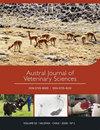犬细小病毒感染内皮糖盏损伤的血清生物标志物
IF 0.8
4区 农林科学
Q3 VETERINARY SCIENCES
引用次数: 4
摘要
犬细小病毒性肠炎(PVE)是幼犬最常见的疾病之一。一系列疾病和炎症条件会导致内皮糖盏(eGCX)破坏,因此,本研究旨在使用eGCX的血清生物标志物来确定PVE犬是否存在eGCX损伤,并评估其在存活和非存活犬中的预后重要性。20只被诊断为PVE的狗和10只健康的两性、混合品种和6个月以下的狗被纳入研究。对狗进行了临床检查、血气分析和全血细胞计数。为了检测eGCX损伤,测量血清内皮细胞特异性分子-1(ESM-1)、syndecan-1(SDC-1)、血管生成素-2(Ang-2)和硫酸乙酰肝素(HS)水平。结果显示,PVE犬入院时血清ESM-1水平高于健康犬。患有PVE的狗被进一步分为两组:幸存者(n:10)和非幸存者(n%10)。ESM-1在区分存活犬和非存活犬方面具有较高的敏感性和特异性,其值分别为100%和67%,最佳分界点≥460 pg/mL。我们得出的结论是,与健康犬相比,PVE犬的ESM-1水平较高可能表明eGCX损伤。此外,非存活犬血清ESM-1的高水平表明,血清ESM-1可能对预测PVE犬的死亡率具有一定的预后作用。本文章由计算机程序翻译,如有差异,请以英文原文为准。
Serum biomarkers of endothelial glycocalyx injury in canine parvoviral infection
. Canine parvoviral enteritis (PVE) is one of the most common diseases in young dogs. A range of diseases and inflammatory conditions can cause endothelial glycocalyx (eGCX) disruption, therefore, this study aimed to determine the presence of eGCX damage in dogs with PVE using serum biomarkers of eGCX, and to evaluate their prognostic importance among survivor and non-survivor dogs. Twenty dogs diagnosed with PVE and 10 healthy dogs of both sexes, mixed-breed, and under 6 months of age were included in the study. Clinical examination, blood gas analysis, and complete blood cell counts of the dogs were performed. To detect the eGCX injury, serum endothelial cell-specific molecule-1 (ESM-1), syndecan-1 (SDC-1), angiopoietin-2 (Ang-2), and heparan sulfate (HS) levels were measured. Results showed that at the time of admission serum levels of ESM-1 were higher in dogs with PVE compared to that of the healthy dogs. Dogs with PVE were further assigned into two groups: survivors (n:10) and non-survivors (n:10). The ESM-1 had high sensitivity and specificity to differentiate between survivor and non-survivor dogs with values of 100% and 67%, respectively, with at an optimum cut-off point of ≥460 pg/mL. We concluded that higher levels of ESM-1 in dogs with PVE may indicate eGCX injury when compared to healthy dogs. Also, the high levels of serum ESM-1 in non-survivor dogs suggest that serum ESM-1 may carry some prognostic usefulness for predicting mortality in dogs with PVE.
求助全文
通过发布文献求助,成功后即可免费获取论文全文。
去求助
来源期刊

Austral Journal of Veterinary Sciences
Veterinary-General Veterinary
CiteScore
1.60
自引率
0.00%
发文量
18
期刊介绍:
Austral Journal of Veterinary Sciences (formerly Archivos de Medicina Veterinaria) publishes original scientific contributions in English, containing the latest developments and discoveries in veterinary sciences. The journal covers topics such as animal health and production, preventive medicine, zoonosis, pharmacology and therapeutics, methods of diagnosis, and other areas related to the veterinary field.
Austral Journal of Veterinary Sciences aims to divulge information about advances in veterinary medicine among universities, research centres, industries, government agencies, biologists, agronomists and veterinarians.
 求助内容:
求助内容: 应助结果提醒方式:
应助结果提醒方式:


